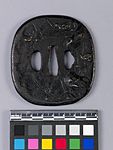Sword Guard
About this object
History of use
Tsuba are placed between the hilt and blade of a sword, forming an essential guard for the hand. Known to exist in Japan at least since the 8th century, they were plain unsigned metal until about the 16th century, when they became enriched artistic expressions usually made to the order of the individual warrior. The central opening, nakago ana, holds the tang of the blade and often has chisel marks or soft metal inserts as adjustments. It is surrounded by a plain surface, the seppa dai, on which the artist's signature may be found. On either side are the kodzuka and kogai openings, for a knife and a skewer respectively; when both are open the guard is intended for a wakazashi blade (less than two feet) and when one or both are plugged or absent the guard is probably intended for the longer katana blade.
Narrative
Marion Stephan Collection. 'Iron' strictly speaking is a pure metal never encountered in antiquity: its alloys, whether natural or deliberately are really forms of steel. There is a long tradition in the literature, however, of referring to the material of a major number of tsuba as iron, which is adhered to in the present catalogue.
Iconographic meaning
Prunus symbolizes winter.
Physical description
Rectangular metal sword guard with low relief design of prunus trunk that grows from lower to upper right on face with spreading branches and has copper highlights inlaid. The reverse has a design of one prunus branch. Nakago ana, four chiselled adjustments; open kodzuka and kogai.
Categories
Materials
Date Made
1840-1860
Date Acquired
10 Jan 1977
How Acquired
Donated
Credit Line
Measurements
Overall: 8.5 cm x 7.8 cm x .5 cm
Object Number
Ed5.3145
